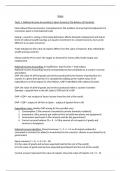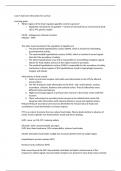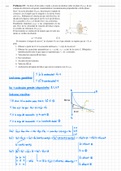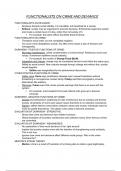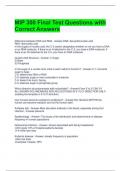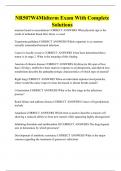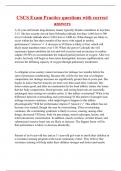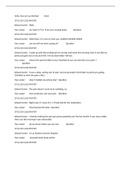Topic 1: National Income Accounting in Open Economy The Balance of Payments
International Macroeconomics: Unemployment: the problem of ensuring full employment in
economies open to international trade
Saving: a country’s saving or borrowing behaviour affects domestic employment and future
levels of national wealth (savings are equal to investment in a closed economy, but can be
different in an open economy)
Trade Imbalances (the value of exports differs from the value of imports): they redistribute
wealth among countries
Money and the Price Level: the supply or demand for money affect both output and
employment
National Income Accounting: In equilibrium: total income = total output.
National Income Accounting records all expenditures that contribute to a country’s income
and output.
GNP: the value of all final goods and services produced by the factors of production of a
country in a given time period. It is calculated by adding up the market value of all
expenditures on final output (in what follows, GNP is identified with national income).
GDP: the value of all final goods and services produced within a country’s borders
Example: a Spanish firm in the UK: Spain’s GNP but UK’s GDP
GNP = GDP + net receipts of factor income from the rest of the world.
GNP = GDP + output of UK firm in Spain – output of Spanish firm in UK
Expenditure view: divides GNP among its four possible uses.
1. Consumption C (the amount consumed by private domestic residents)
2. Investment I (the amount put aside by firms to build new plants and equipment)
3. Government purchases G (the amount used by the government)
4. Current account balance CA = X – M (the amount of net exports of goods and
services to foreigners)
National Income Identities: Closed economy: Y = C + I + G so all output produced is
consumed or invested (or added to inventories) by the country’s citizens or purchased by its
government
Open economy Y = C+ I + G + (X – M)
X is the value of goods and services exported (sold to the rest of the world)
M is the value of goods and services imported (purchased from the rest of the world)
Current account represents the value of exports minus the value of imports: CA = X – M
,If CA > 0 (X > M), current account surplus: the country lends to the rest of the world
(accumulates foreign credit)
If CA < 0 (X < M), current account deficit: the country is borrowing from the rest of the
world, consumption depends more on foreign imports (accumulates foreign debt)
National saving S is the proportion of output that is not devoted to private consumption or
public consumption G: S = Y – C – G
A closed economy can only build its capital stock by saving
Y =C + I+ G→ S=I
An open economy can build its capital stock by saving or by acquiring foreign wealth
Or in other words, an open economy can save either by building up its capital stock
or by acquiring foreign wealth
Y =C + I+ G+ CA→ S=I +CA
Therefore, Current Account is also defined as difference between savings and investment:
CA=S−I
In an open economy, it is possible to increase investment without increasing savings
An open economy’s current account surplus is often referred to as net foreign investment
because a country’s savings can be borrowed by a second country to increase its stock of
capital (net foreign investment)
Three Definitions of the Current Account:
Difference between the value of exports and of imports CA = X – M
Borrowing (CA < 0) or lending (CA > 0) to the rest of the world
Difference between saving and investment CA = S – I
Private saving (part of disposable income saved rather than consumed)
S p=Y −T −C
Government saving (T is net tax revenue)
g
S =T −G
National saving S p + S g
S=S p+ S g =Y −T −C +T −G
= Y −C−G
¿ I + CA
p
It can be shown that S =I +CA +(G−T )
p g
S =I +CA −S
In the early 1980s, the US decreased taxes and raised government expenditures, generating
both a big government AND current account deficits i.e. “twin deficits”
S p=I +CA+(G−T )
CA=S p−I −(G−T )
Balance of Payments Accounting: It records all transactions between a country and the rest
of the world during a time period (payment to foreigners in debit of the BP (<0) and receipt
from foreigners in credit (>0))
Three types of transactions are recorded:
1. Transactions that involve goods and services (e.g., jeans exported from the UK to
France: credit in UK BP): current account CA
, 2. Transactions that involve financial assets (any form in which wealth can be held e.g.
money, factories): financial account FA
3. Transfers of wealth between countries (non-market activities, e.g., copy-rights):
capital account KA.
In modern day, CA = CA + KA and KA = FA
Every transaction enters the balance of payments twice, once as a credit and once as a
debit.
If BP < 0, payment to foreigners in debit and if BP > 0, payments to foreigners in credit
The Fundamental Balance of Payments Identity:
Given that any transaction gives rise to two different offsetting entries in the balance of
payments, it must be that: CA + FA + KA = 0
1. You buy a car abroad paying £10,000. Your payment enters the current account in
debit with a negative sign. Then the car company deposits your check in a bank, so
purchases a UK asset (a “promise” to be paid), and the transaction shows up as
£10,000 credit in the UK financial account.
2. You buy a factory abroad for £50,000. This is not a good nor a service, but a financial
asset: the transaction is recorded in the financial account.
The Financial Account measures the difference between sales of assets to foreigners and
purchases of assets bought abroad:
Nonreserve financial account: “private” transactions (non-Central Banks)
Official reserve transactions (Central Bank transactions)
Official international reserves are held by Central Banks to affect macroeconomic conditions
(“official foreign exchange intervention”) through the
injection or withdrawal of money in circulation
Foreign official reserves increased by $35.9bn
(foreign Central Banks increased their reserves,
“export”)
US official reserves (international reserves held
by the Central Bank) rose by $0.3bn (“import”)
Variation in official reserves is $35.6bn, and
covers the US current deficit
BP−∆ reserves=CA+ KA+ NRFA=−∆ reserves
Central bank reserves = X – M where X is foreign CB buying domestic assets and M is
domestic CB buying foreign assets. ∆ reserves =X−M
Money Supply in an Open Economy: The banking system consists of the Central Bank and of
Commercial banks.
Central Bank’s (CB) balance sheet:
Assets Liabilities
FX – foreign exchange reserves, gold MB – monetary base (currency issued)
LG – lending to the goverment
Commercial Bank’s balance sheet:
Assets Liabilities
b
M B – Currency plus deposits with the CB D – deposits by the public
, L – loans to personal and corporate sector
Consolidated Banking Sector:
FX+ LG ≡ MB
b
M B +L≡ D
b
→ FX + M B + ( LG+ L ) ≡ MB + D
LG + L is the total consolidated banking sector’s lending i.e., domestic credit DC
MB−M Bb is total monetary base net of that part which is in the coffers of the banks
themselves, i.e., M B p (currency in circulation)
M B p + D is total currency in circulation plus deposits in the banks, i.e., money stock
Ms
s
FX + DC ≡ M
Money supply is the sum of domestic credit and the value of the country’s reserves
of gold and foreign currency held by the Central Bank
Topic 2: Intertemporal Approach to the Current Account:
Difference between open and closed economies: an open economy can borrow resources
from the rest of the world or lend them abroad.
Resource exchanges across time are called Intemporal Trade (measured by the current
account and the balance of payments)
Here, we will describe how a country can gain from rearranging the timing of its
consumption through international lending and borrowing.
Small Two-Period Endowment Economy: Small open economy model
Two period economy, t = 1, 2
Consumes a single good
The rate r at which the economy can borrow or lend is given (exogenously by world capital
markets)
Representative household: we do not distinguish between aggregate and individual
variables. Everyone acts the same
Consumers Preferences: A consumer maximises lifetime (t =1,2) utility U which depends on
consumption levels in both periods U =u ( C1 ) + βu ( C 2 ) (1)
where β ∈ ( 0,1 ) is a fixed subjective discount factor measuring the impatience to consumer,
C is consumption of goods and u the period utility function with u' >0 and
u' ' < 0 – decreasing marginal utility of consumption
C2 Y2
Lifetime Budget Constraint: C 1+ =Y 1 + ( 2) where Y is individual output, r the real
1+r 1+ r
1
interest rate for borrowing or lending in t=1 and is the market discount factor for
1+ r
future consumption.
The constraint means that the present value of consumption is equal to the present value of
output.
Output Y is perishable
Perfect foresight of the future (no uncertainty)

